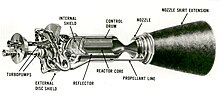NERVA


NERVA (Nuclear Engine for Rocket Vehicle Application) war ein von 1954 bis 1972 von der NASA geführtes Programm zur Entwicklung einer nuklear angetriebenen Raketenstufe für den bemannten Flug zum Mars.
Das Projekt begann, als 1955 das Los Alamos Scientific Laboratory der US Atomic Energy Commission und die US Air Force nach neuen Raketenantrieben suchten. Die neu gegründete NASA übernahm das Projekt 1958 von der US Air Force und untersuchte dessen Anwendbarkeit auf Langzeit-Raumfahrtmissionen. Hauptelement dieses Antriebes war ein Kernreaktor, der durchgeleiteten Wasserstoff auf 3000 °C erhitzte, der beim Ausströmen die Rakete als Stützmasse vorwärts treiben sollte.
NERVA kam über einige Bodentests auf dem Atombombentestgelände in Nevada nicht hinaus. Die Nixon-Regierung beschnitt das Budget des Projektes dramatisch, als Anfang der 1970er Jahre das öffentliche Interesse an der Raumfahrt nach der letzten Mondlandung 1972 zurückging. Nachfolgeprogramm war das 1992 eingestellte Projekt Timberwind.
2019 bewilligte der Kongress der Vereinigten Staaten 125 Millionen US-Dollar für die Entwicklung von Raketen mit nuklearem Antrieb.[1] Im Januar 2023 kündigten die NASA und die Defense Advanced Research Projects Agency (DARPA) an, bei der Entwicklung eines nuklear-thermischen Raketentriebwerks zusammenzuarbeiten und im Weltraum zu testen, um nukleare Antriebsfähigkeiten für bemannte NASA-Missionen zum Mars zu entwickeln.[2]
Technische Daten
- Durchmesser: 10,55 m
- Länge: 43,69 m
- Leergewicht: 34.019 kg
- Gewicht betankt: 178.321 kg
- Schub im Vakuum: 867 kN
- spezifischer Impuls () im Vakuum: 825 s (8,09 kN·s/kg = 8090 m/s)
- auf Meereshöhe: 380 s (3,73 kN·s/kg = 3730 m/s)
- Brenndauer: 1200 s
- Treibstoff: Kernreaktor/LH2
- Düsen: 1 Nerva-2
Risiken
Die Gefahren sind vergleichbar mit Störfällen oder dem Versagen eines Kernreaktors, jedoch aufgrund der Komplexität einer nutzlastoptimierten Rakete weit schwieriger zu beherrschen. Der erhitzte Wasserstoff ist radioaktiv, so dass nukleare Triebwerke erst im Orbit eingesetzt werden könnte. Selbst dann ist eine gute Abschirmung der Nutzlast vor der Strahlung nötig.[3]
Siehe auch
Weblinks
- David S. F. Portree: The Last Days of the Nuclear Shuttle (1971) (englisch)
- Bernd Leitenberger: Nukleare Antriebe
- Los Alamos National Laboratory: NUCLEAR ROCKETS: To Mars and Beyond (englisch)
- Encyclopedia of Science: NERVA (Nuclear Engine for Rocket Vehicle Application) (englisch)
Einzelnachweise
- ↑ Cain Fraser: Earth to Mars in 100 days: The power of nuclear rockets. phys.org, 1. Juli 2019, abgerufen am 30. März 2024 (englisch).
- ↑ Roxana Bardan: NASA, DARPA Will Test Nuclear Engine for Future Mars Missions. NASA, 24. Januar 2023, abgerufen am 30. März 2024 (englisch).
- ↑ Bernd Leitenberger: Nukleare Antriebe. Abgerufen am 30. März 2024.
Auf dieser Seite verwendete Medien
An explanatory drawing of the NERVA (Nuclear Engine for Rocket Vehicle Application)thermodynamic nuclear rocket engine. The main objective of project Rover/NERVA was to develop a flight rated engine with 75,000 pounds of thrust. The Rover portion of the program began in 1955 when the U.S. Atomic Energy Commission's Los Alamos Scientific Laboratory and the Air Force initially wanted the engine for missile applications. However, in 1958, the newly created NASA inherited the Air Force responsibilities, with an engine slated for use in advanced, long-term space missions. The NERVA portion did not originate until 1960 and the industrial team of Aerojet General Corporation and Westinghouse Electric had the responsibility to develop it. In 1960, NASA and the AEC created the Space Nuclear Propulsion Office to manage project Rover/NERVA. In the following decade, it oversaw a series of reactor tests: KIWI-A, KIWI-B, Phoebus, Pewee, and the Nuclear Furnace, all conducted by Los Alamos to prove concepts and test advanced ideas. Aerojet and Westinghouse tested their own series: NRX-A2 (NERVA Reactor Experiment), A3, EST (Engine System Test), A5, A6, and XE-Prime (Experimental Engine). All were tested at the Nuclear Rocket Development Station at the AEC's Nevada Test Site, in Jackass Flats, Nevada, about 100 miles west of Las Vegas. In the late 1960's and early 1970's, the Nixon Administration cut NASA and NERVA funding dramatically. The cutbacks were made in response to a lack of public interest in human spaceflight, the end of the space race after the Apollo Moon landing, and the growing use of low-cost unmanned, robotic space probes. Eventually NERVA lost its funding, and the project ended in 1973.
The NRX A-1 nuclear thermal engine being test fired at Area 25 (Nuclear Rocket Development Station in Jackass Flats) in the Nevada Test Site.

